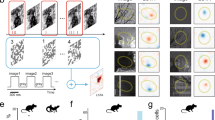Abstract
Our eyes see so much in such varied conditions that one might consider the question posed in the title to be meaningless, but we show here that, within the range that we have been able to test, there is a particular spatiotemporal pattern of light that is detected better than any other. At least two plausible theories of visual detection predict that a stimulus will be seen best (will have greatest quantum efficiency) when it matches the weighting function of the most efficient detector. We have measured quantum efficiency for detecting a wide variety of spatiotemporal patterns using foveal vision in bright light. The best stimulus found so far is a small, briefly exposed circular patch of sinusoidal grating having a spatial frequency of ∼7 c deg−1, drifting at ∼4 Hz. We propose that this is the weighting function of the most efficient human contrast detector. We believe this answer to the question is unexpected and may have fundamental implications with regard to the mechanisms of visual perception.
This is a preview of subscription content, access via your institution
Access options
Subscribe to this journal
Receive 51 print issues and online access
$199.00 per year
only $3.90 per issue
Buy this article
- Purchase on Springer Link
- Instant access to full article PDF
Prices may be subject to local taxes which are calculated during checkout
Similar content being viewed by others
References
Hartline, H. K. Am. J. Physiol. 130, 700 (1940).
Barlow, H. B. J. Physiol., Lond. 119, 69 (1953).
Enroth-Cugell, C. & Robson, J. G. J. Physiol., Lond. 187, 517–552 (1966).
Lennie, P. Vision Res. 20, 561–594 (1980).
Movshon, J. A., Thompson, I. D. & Tolhurst, D. J. J. Physiol., Lond. 283, 53–77 (1978).
De Valois, R. L., Albrecht, D. G. & Thorell, L. G. in Frontiers of Visual Science (eds Cool, S. J. & Smith, E. L.) 544–556 (Springer, New York, 1978).
Fisher, R. A. Statistical Methods for Research Workers (Oliver & Boyd, Edinburgh, 1925).
Rose, A. Proc. Instn Radio Engrs 30, 293 (1942); Vision: Human and Electronic (Plenum, New York, 1973).
Tanner, W. P. Jr & Birdsall, T. G. J. acoust. Soc. Am. 30, 922–928 (1958).
Barlow, H. B. Vision Res. 18, 637–650 (1978).
Levinson, J. Z. J. opt. Soc. Am. 58, 1558 (1968).
Watson, A. B. Vision Res. 19, 515–522 (1979).
Robson, J. G. & Graham, N. Vision Res. 21, 409–418 (1981).
Barlow, H. B. in Vertebrate Photoreception (eds Barlow, H. B. & Fatt, P.) 337–358 (Academic, New York, 1977).
Burgess, A. E., Wagner, R. F., Jennings, R. J. & Barlow, H. B. Science 214, 93 (1981).
Robson, J. G. & Graham, N. Vision Res. 21, 409–418 (1981).
Watson, A. B. Vision Res. 22, 17–25 (1982).
Thomas, J. P. & Gille, J. J. opt. Soc. Am. 69, 652–660 (1979).
Watson, A. B. & Robson, J. G. Vision Res. 21, 1115–1122 (1981).
Gabor, D. J.IEE London 93(III), 429–457 (1946).
Helstrom, C. W. IEEE Trans. Inf. Theory IT-13, 81–82 (1966).
Marcelja, S. J. Opt. Soc. Am. 70, 1297–1300 (1980).
Sakitt, B. & Barlow, H. B. Biol. Cybern. 43, 97–108 (1982).
Author information
Authors and Affiliations
Rights and permissions
About this article
Cite this article
Watson, A., Barlow, H. & Robson, J. What does the eye see best?. Nature 302, 419–422 (1983). https://doi.org/10.1038/302419a0
Received:
Accepted:
Issue Date:
DOI: https://doi.org/10.1038/302419a0
This article is cited by
-
Extended perceptive field revealed in humans with binocular fusion disorders
Scientific Reports (2023)
-
Monocular and Binocular Temporal Visual Perception of Infantile Nystagmus
Scientific Reports (2020)
-
The intrinsically restructured fovea is correlated with contrast sensitivity loss in Parkinson’s disease
Journal of Neural Transmission (2020)
-
Computing by modulating spontaneous cortical activity patterns as a mechanism of active visual processing
Nature Communications (2019)
-
The spatial range of peripheral collinear facilitation
Scientific Reports (2015)
Comments
By submitting a comment you agree to abide by our Terms and Community Guidelines. If you find something abusive or that does not comply with our terms or guidelines please flag it as inappropriate.



